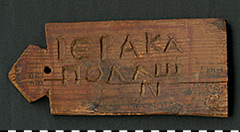SB I 3447 (ÄM 13353)
A gravestone with instructions for transporting the deceased? That is unthinkable today. In Roman Egypt, however, instead of gravestones, wooden mummy labels were often used, attached to the mummy before it was transported to the place of burial. Sometimes this label also contained instructions for transport, as on the Greek mummy label presented here.
It was an ancient Egyptian custom to attach a small wooden label to mummies, which provided information about the deceased. Tying such wooden labels to mummies is a custom that appeared in Egypt from the 1st century AD at the latest and remained popular in the following centuries. They have at least one hole through which a cord could be pulled to attach the label to the mummy.
The main purpose of the mummy labels was to identify the embalmed corpses. So they gave the name of the deceased and usually also the names of the parents and grandfather. This was often followed by a statement of the age of the deceased. Occasionally, the day of death and an origin were also mentioned. Sometimes we even learn something about the profession of the deceased from these usually very short texts. Many mummy labels also contained freight instructions for the mummy, which provided information about costs, places of dispatch and destination, and details of the transport. Most demotic mummy labels also bear religious formulas that are also found on grave stelae, such as the invocation to the Ba-’soul‘ to be permanently alive. The mummy labels thus represented a kind of substitute for a gravestone, which would have been too expensive for most people. They belonged exclusively to the deceased of the lower class.
Like many other mummy label, this particular specimen has the form of a one-sided tabula ansata, i.e. the left side runs out into a handle containing the hole for the cord, the right side is finished straight. A special feature, however, is the drawing on the mummy label. Another one-sided tabula ansata was drawn on the label with red ink or paint. Its handle extends into the handle of the wooden tabula ansata. The hole was probably drilled later, as it partially destroys the red line.
This drawn tabula ansata serves as a frame for the name of the deceased, Hierakapollon, which was carved into the wood in three lines. In doing so, the scribe paid attention to the length of the lines given by the red frame, which resulted in the last letter of the name being in the third line alone. The individual letters were originally filled in red, of which a few traces have survived on the cut edges and in the indentations of the last letter of the first line.
Below and to the right of the red frame, four lines were added in black ink, the letters of which were not cut into the wood. As they were written in cursive Greek script, in contrast to the name of the deceased, they can easily be dated to the 2nd – 3rd century AD. These lines contain very brief instructions on how to deal with the mummy of Hierakapollon. Under the frame it is written that the mummy should be brought to the nome Panopolites. On the right it is stated that it is to be handed over to the undertaker Sekes. His name and job title were corrected in two places by the same scribe.
This Mummy label with instructions for transport was on display in the special exhibition „Akhmim – Egypt’s Forgotten City“.



